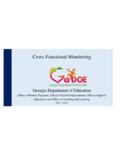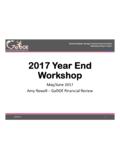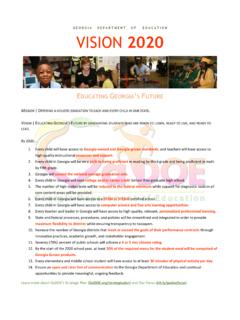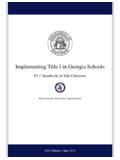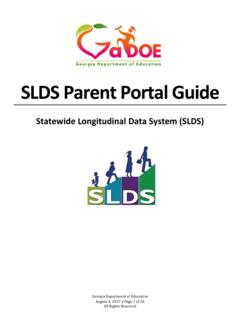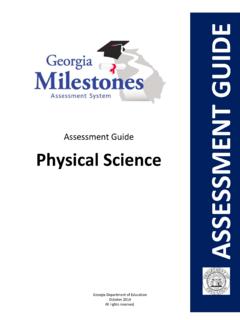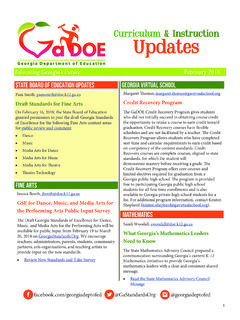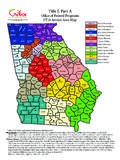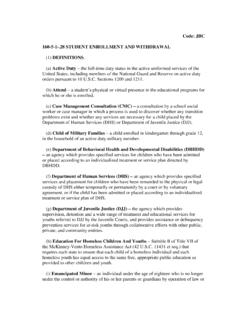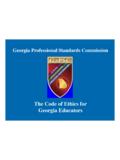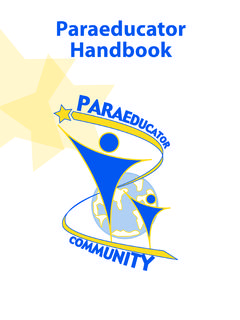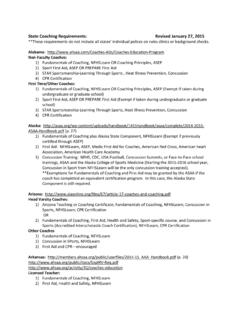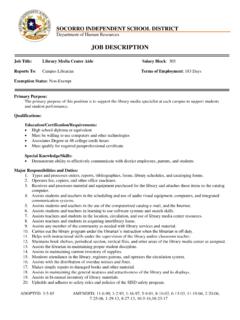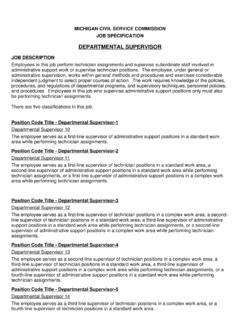Transcription of Code: IEC - Georgia Department of Education
1 code : CLASS SIZE.(1)D EFINITIONS.(a) Ar e as ofExceptionality -Areas of exceptionality with maximum class sizes are S/L: Speech-Language Impairment2 . D/H H: D eaf/H ard of H earing3 . LD: Specific Learning Disability4 . EBD: Emotional and Behavioral Disorder5. M ID: M ild Intellectual Disability6 .SID: Severe Intellectual Disability7 . M OID: M oderate Intellectual D isability8 . 01: Orthopedic Impairment9 . PID: Profound Intellectual Disability10. V I: V isual Impairment11 . DB: Deaf-Blind12 . SED: Severe, Emotional and B ehavioral Disorder13 . SD D: Significant D evelopm ental D elay(b) Early Intervention Program (EIP)- Program to serve students i n grades K through 5who are at risk of not reaching or maintaining academic grade level to obtain the necessary skillsto reach grade-level performance in the shortest possible time as specified in Rule Intervention Program.
2 (c)Gifte dAdv ance d C ontentDeliveryModel- Achievement-grouped advanced classes inacademic content areas. The curriculum is differentiated in content, pacing, process-skillsemphasis, and expectation of student achievement to provide challenge for gifted learners. (Examples:m iddle school A Igebra I; H onors/A P/IB courses)(d) GiftedResourceClassDeliveryModel- Classesforgiftedstudents that em phasizeinterdisciplinary enrichm ent. Althoughthe curriculum hasacademiccontent, the instructionfocuses on thinking skills, problem solving, research and com m unication skills, and creativeproductivity. (Example: Elementary Pull-Out Enrichment Class)(e) Individual Class Size FundingRatio -The number of students needed to earn state funds,calculated on the base amount, to pay for a single class in each of the QBE formula programs.(f)InstructionalExtension-a state-funded instructional program beyond the regularschool day to address the academic needs of low-performing students.
3 (g) Maximum Individual Class Size-M aximum number of students that may be taught by a teacherin a class 5 - 1 - . 08( Conti nued)(h)Phys ic al C la ssroom-The maximum class size for grades K-3 is applicable to thephysical classroom. The physical classroom is the space used for the purposes of instruction tostudents. By way of example, to have more than twenty-one students in a K-3 classroom willrequire a divider, temporary or permanent. Whether the partition is temporary or permanent, thesystem shall obtain the approval of the fire marshal and the Facilities Division at the Georgia Departmentof Education .(i)RemedialEducationProgram- an instructional program designed for students in grades6-12 who have identified deficiencies in reading, writing, and math as identified by Rule 160-4-5- .01 Remedial Education (j)ResourceDelivery Model- Instruction for studentswith disabilities outside the regularclassroom for three or fewer segments of the instructional day.
4 (k)Self-ContainedDeliveryModel- Instruction for students with disabilities in one area ofexceptionality for four or more segments of the instructional day.(2) REQUIREMENTS.(a) Local boards of Education and schools shall comply with maximum class sizes and schedules listedin AppendicesA -F.(b) Paraprofessionals may be used to increase class size only as provided in the appendices. Localboards of Education shall ensure that state funds earned for paraprofessionals in kindergarten shall be usedto provide paraprofessional services to all kindergarten classes.(c) Local boards of Education not complying with maximum class size requirements shall be subject to aloss of funding for the entire class or program that is out of compliance. A school shall not count for FTEpurposes any class that exceeds the m axim um class size as provided in the appendices. H owever,aschool shall count vocational labs and remedial classes that exceed m axim um class size only as regularclasses, provided they do not exceed the maximum regular class size.
5 (d) The num ber of students taught by a teacher at any time after the first 15 school days of a school yearmay not exceed the maximum such number unless requested authorization for a specific larger number isapproved by the State Board. The State Board may approve a request only in the limited circumstanceswhere educationally justified and where an act of God or other unforeseen event led to the precipitous risein enrollm ent within that system, or led to another occurrence which resulted in the local board's inabilityto comply with the maximum class size requirement. The State Board may approve requests for increasesto m axim um individual class sizes only. It shall not approve requests for increases to system averageclass sizes and it shall not approve requests for language arts, m ath, science, or social studies in 5 - 1 - . 08( Conti nued)(e) The maximum class size for the kindergarten and primary grades programs is defined as the numberof students in a physical classroom.
6 The m axim um individual class size for all other purposes shall bedefined as the maximum number of students that may be taught by a teacher in a class segment.(f) Beginning with the 2007-2008 school year, each local board of Education shall establish maximumclass sizes for general Education programs in mathematics, science, social studies, and language arts forgrades 9 through 12 that shall not exceed the funding size by more than 39 percent (see Appendix A) andshall annually report to the state board and to each school council in its school system such class sizesestablished. Compliance with maximum class size requirements for all other subjects in grades 9-12 shallbe determined by the system average for applicable programs and grades. Individual class size for suchprograms and grades shall not exceed the applicable maximum system average by more than two uthority O.
7 C . G. A . 20 -2 - 151(b ) ; 20 -2 - 152(a ) ; 20 -2 -153; 20 -2 - 154;20 -2 - 182( g ), (h ) .Adopted: August 9, 2007 Effective: August 29, 20073160-5- 1 - . 08 (Continued)AppendixARegular and Vocational ProgramsFundingMaxi mum Indi v i dualGrade(s ) Subiect( s)ClassClass Si zeS izeRegular 15 18 KindergartenRegularKindergarten 15 20 With full-timeparaprofessionalRegular Grades 1-3 17 21No ParaprofessionalRegular Grade 1-3 With full-time 17 21paraprofessionalGrades 4-5 English, Math, 23 28 Science, SocialStudiesGrades 6-8 English, Math, 23 28 Science, SocialStudiesGrades 6-8 Middle Schools Allacademic classes asdefined in Rule 160- 20 MiddleSchool ProgramCriteriaFundingMaxi mum Indi v idualGrade(s ) Subiect( s)ClassClass Si zeS i zeFine Arts K-3 NA 33 Fine Arts & ForeignLanguage NA 33 InstructionalProgramsGrades 4-5 Fine Arts&Foreign Language NA 33 InstructionalProgramsGrades 6-8 Grades 4-8 All others 23 33(see exceptions)160-5- 1.
8 08 (Continued)Fundinq Maxi mum Indiv idual Class SizeGrade( s) Subiect( s)ClassS i zeGrades 9-12 English, Math,Social Studies, 23 32*Science, ForeignLanguageFundingMaxi mumSystem Avg. ClassGrade( s) Subiect( s)Class SizeS i zeAll other Subjects 23 35 Grades 9-12 Vocational Labs 20 28 RemedialGrades 6-12 15 18No paraprofessionalRemedialGrades 6-12 15 24 With full-timeparaprofessional*Local boards of Education shall establish class size maximums for these courseswhich shall not exceed the funding size by more than 39 1 - . 08 (Continued)Exceptions to Maximum Class-size for Grades K-12 shall be as follows:Course Maximum Individual ClassSize(i) Typing/Keyboarding 35(ii) Instrumental Music (e. g, band) 100(iii) Choral Music 80(iv) Physical Education 40No paraprofessionalPhysical Education 54 With paraprofessional Elementa schools(v) Co-op Supervision 56* Defined as class size by full-time equivalent reporting 1.
9 08 (Continued)Appendix BStudents with DisabilitiesClass Group/ Excepti onFundingExcepti on to Maxi mumProgramClass Size Maxi mum Indi vi dual Class Size 2 SegmentsPerDayPer Teacher* **With Paraprofessional1 . GroupI(i) S/L-SC 8 11 15 +1(ii) LD-SC 8 12 16 +12 . Group II(i) MID-SC 10 13 +1(ii) MID-R 10 13 +13 . Group III(i) SID-SC 5 NA 7 +1(ii) D/HH-SC 5 6 8 +1(iii) S/L-R 5 7 NA NA(iv) BD-R 5 7 10 +1(v) LD-R 5 8 10 +1(vi) BD-SC 5 8 11 +1(vii) MOID-SC 5 NA 11 +1(viii) 01-SC 5 NA 1104. Group IV(i) D/HH-R 3 3 4 +1(ii) VI-R 3 3 4 +1(iii) OI-R 3 4 5 +1(iv) VI(DB)-SC 3 NA 6 +1(v) P I D-SC 3 NA 605 . Group V 8 NA NA NANOTE:Each paraprofessional is the equivalent to 1/3 teac her and affect sindividualc lass size ous teacher/paraprofess ional models shall be averaged 1 - . 08 (Continued)NOTE:If students from different exceptionalities programs are within the same segment, the maximum class sizeshall be determined by the program with the smallest class :Middle school and high school students served in a departmental model shall have an individual maximumclass size of seven without a paraprofessional and ten with a paraprofessional, provided the number of students ofany one exceptionality within the class does not exceed the individual maximum class size for that TO INDIVIDUAL MAXIMUM CLASS SIZE: The individual maximum class size with aparaprofessional may be increased as noted for two segments per day per teacher for the remainder of the schoolyear.
10 Maximum teacher/pupil ratio without a paraprofessional may not be increased. (See also Rule 160-4-7).*No paraprofessional ** With paraprofessional9160-5- 1 - . 08 (Continued)APPENDIXCG ifted and Alternative ProqramsMaxi mum System AverageClass/ Group Exception Plan Fundi ng Class Class Si z eS i ze1 . GIFTED(i) Elementary Resource ( K-5) 12 17(ii) Middle School Resource and 12 21 Advanced Content (6- 8)(iii) High School Resource and AdvanceContent (9 -12) 12 21 FundingClass Maxi mumSystem Avg. ClassClass/ Group Excepti on PlanS izeSi ze2 . ALTERNATIVE PROGRAMSNo paraprofessional 15 18 With full-time paraprofessional 15 24** The expectation is that a recommendation will be made that beginning with the 2008-2009 school year this will be reduced to 1 - . 08 (Continued)APPENDIXDE nqlish to Speakers of Other Lanquaqes (ESOL)Grade(s)M aximumSystem AverageClass SizeSubject(s)FundingClass SizeNoParaprofessionalWithParaprofession alK-3 7 11 134-8 7 14 159-12 7 18 2011160-5-1.
